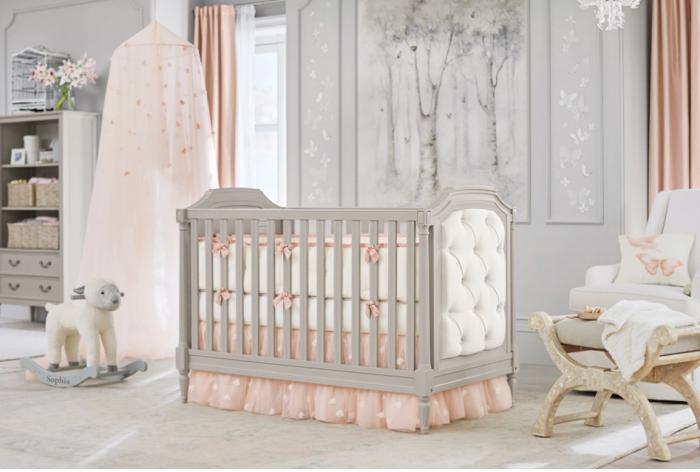When it comes to choosing a crib for your baby, safety is the top priority for parents. Pottery Barn is a popular brand known for its stylish and high-quality nursery furniture. However, many parents wonder about the safety of Pottery Barn cribs. In this article, we will explore the safety features, standards, and potential concerns regarding Pottery Barn cribs.
Overview of Pottery Barn Cribs
Pottery Barn offers a variety of cribs designed for infants and toddlers. Their cribs come in different styles, colors, and finishes. Many parents appreciate the aesthetic appeal of Pottery Barn cribs. They can fit well with various nursery themes. However, while style is important, safety should always come first.
Pottery Barn cribs are made from solid wood or engineered wood. The brand claims to prioritize durability and safety in their designs. Cribs from Pottery Barn are often available in both convertible styles and traditional designs. Convertible cribs can change from a crib to a toddler bed or even a full-size bed. This feature is appealing to many parents looking for long-term use.
Safety Standards and Certifications
One of the most important factors to consider when evaluating crib safety is whether the crib meets safety standards. Pottery Barn cribs are built to comply with the safety standards set by the Consumer Product Safety Commission (CPSC).
The CPSC sets regulations for cribs to ensure they are safe for infants and toddlers. These regulations cover aspects such as:
Slat Spacing: The spacing between crib slats must be less than 2 3/8 inches to prevent a baby’s head from getting stuck.
Stability: Cribs should not wobble or tip over easily.
Non-toxic Materials: Cribs must be made from non-toxic finishes and materials to keep babies safe from harmful chemicals.
Pottery Barn also tests its cribs for structural integrity and durability. This testing ensures that the crib can withstand regular use and provides a safe sleeping environment for your child.
Quality of Materials
Pottery Barn cribs are constructed from high-quality materials. The wood used in their cribs is sourced responsibly. Many parents appreciate that the brand emphasizes sustainability in its production processes.
The finishes on Pottery Barn cribs are often non-toxic. This means they do not contain harmful chemicals. However, it is essential for parents to check the specific model and finish before purchasing. Not all finishes may be equally safe.
While the brand claims to use safe materials, parents should always verify that the specific crib model has been tested for lead and other harmful substances. This information is often available on the product page or from customer service.
Customer Reviews and Feedback
Customer feedback can provide valuable insights into the safety and quality of Pottery Barn cribs. Many parents report satisfaction with the design and safety features of these cribs. They appreciate the solid construction and the ability to convert the crib as their child grows.
However, some reviews raise concerns about assembly. Parents have noted that the assembly process can be complicated. Improper assembly can lead to safety issues. It is crucial for parents to follow the instructions carefully and ensure that the crib is assembled correctly.
Additionally, some parents have reported issues with paint chipping or scratches. This can occur over time, especially with heavy use. Regular maintenance and care can help preserve the finish of the crib and ensure it remains safe for use.
Common Concerns with Cribs
Despite Pottery Barn’s commitment to safety, parents should remain vigilant about common crib concerns. Here are some potential issues to consider:
1. Suffocation Risks
One of the most significant concerns for parents is the risk of suffocation. To reduce this risk, it is crucial to follow safe sleep guidelines. Always place babies on their backs to sleep. Avoid placing soft bedding, pillows, or stuffed animals in the crib, as these can increase the risk of suffocation.
2. Potential for Falls
As your child grows and begins to stand or climb, the risk of falls increases. Parents should transition their child to a toddler bed when they can climb out of the crib. Pottery Barn cribs with a convertible feature can make this transition easier.
3. Age of the Crib
Another consideration is the age of the crib. If you purchase a used Pottery Barn crib, ensure it meets current safety standards. Older cribs may not comply with the latest regulations. Check for recalls and ensure all parts are intact.
Maintenance Tips for Safety
To ensure your Pottery Barn crib remains safe for your child, regular maintenance is essential. Here are some tips to keep in mind:
Check for Stability: Regularly check the crib to ensure it remains stable and does not wobble.
Inspect for Damage: Examine the crib for any signs of wear or damage. Look for cracks, splintered wood, or loose screws.
Clean Regularly: Use non-toxic cleaners to wipe down the crib. This helps keep the surface clean and free from harmful substances.
Monitor the Mattress Height: As your child grows, adjust the mattress height as needed. Lower the mattress when your baby starts to pull up or stand.
See also: Are Vertical Crib Liners Safe
Final Thoughts
In conclusion, Pottery Barn cribs are generally safe for infants and toddlers. They meet essential safety standards and are constructed from high-quality materials. However, parents must remain vigilant about assembly and maintenance.
By following safe sleep guidelines and regularly checking the crib for stability and damage, you can create a safe sleeping environment for your child.
Always prioritize safety over aesthetics when choosing a crib. If you have any doubts about a specific model, do not hesitate to reach out to Pottery Barn’s customer service for further information.
Ultimately, a safe crib can provide peace of mind and help ensure your baby gets the restful sleep they need.
Related topics:


